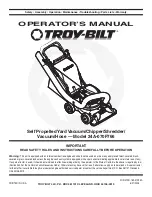
3
• Do not use the vacuum in areas where flammable or
combustible liquids, such as gasoline, may be present.
• Do not vacuum fine, combustible dust particles that can
ignite and potentially lead to an explosion.
•
Do not put foreign objects into openings. Do not use the
vacuum with any opening blocked; keep all openings free
of dust, lint, hair, and anything that may reduce air flow.
•
Always check the hose and the unit when vacuuming.
• Check the float often.
• If you notice liquid leaking from your appliance, switch it
off immediately and remove the battery.
•
When using the blower function:
i)
Direct air discharge at work area only – never at
people or animals.
ii)
Do not use blower as a sprayer in wet mode.
iii)
Wear a dust mask and protective eye wear.
IMPORTANT!
If the hose or tools are blocked, switch off
the vacuum and remove the blockage(s) before re-starting your
machine.
IMPORTANT!
Cleaning filters and replacing them regularly
maintains vacuum performance. It's recommended that your
filters should be checked, cleaned and replaced periodically.
B Charger Safety
Instructions
We pay a great deal of attention to the design of every battery
pack to ensure that we supply you with batteries that are safe,
durable and have a high energy density. The battery cells have
a wide range of safety devices. Each individual cell is initially
formatted and its electrical characteristic curves are recorded.
This data is then used exclusively to be able to assemble the
best possible battery packs.
Despite all the safety precautions, caution must always be
exercised when handling batteries. The following points must
be obeyed at all times to ensure safe use. Safe use can only
be guaranteed if undamaged cells are used. Incorrect handling
of the battery pack can cause cell damage.
IMPORTANT!
Analyses confirm that incorrect use and poor
care of high-performance batteries are the main factors
responsible for personal and/or product damage.
m
WARNING!
Use only approved replacement batteries;
other batteries may damage the cordless wet/dry vac and
cause it to malfunction, which can lead to serious personal
injury.
m
WARNING!
Do not use a battery pack or appliance that
is damaged or modified. Damaged or modified batteries may
exhibit unpredictable behavior resulting in fire, explosion or risk
of injury.
Do not modify or attempt to repair the battery pack except as
indicated in the instructions for use and care.
Have your battery pack serviced by a qualified repair person
using only identical replacement parts. This will ensure that the
safety of the battery pack is maintained.
m
CAUTION!
To reduce the risk of injury, charge the
Snow Joe
®
24V iON+ lithium-ion battery pack only in its
designated Snow Joe
®
24V iON+ lithium-ion charger. Other
types of chargers present risk of fire, personal injury and
damage. Do not wire a battery pack to a power supply plug or
car cigarette lighter. Such misuse will permanently disable or
damage the battery pack.
•
Avoid dangerous environments –
Do not charge the
battery pack in rain, snow or in damp or wet locations.
Do not use the battery pack or charger in the presence of
explosive atmospheres (gaseous fumes, dust or flammable
materials) because sparks may be generated when inserting
or removing the battery pack, which could lead to a fire.
•
Charge in a well-ventilated area –
Do not block the
charger vents. Keep them clear to allow for proper
ventilation. Do not allow smoking or open flames near a
charging battery pack. Vented gases may explode.
NOTE:
The safe temperature range for the battery is
41°F – 105ºF (5°C – 40.5°C). Do not charge the battery
outside in freezing weather; charge it at room temperature.
•
Maintain charger cord –
When unplugging the charger, pull
the plug, not the cord, from the receptacle to reduce the
risk of damage to the electrical plug and cord. Never carry
the charger by its cord or yank it by the cord to disconnect
it from the receptacle. Keep the cord away from heat, oil
and sharp edges. Make sure the cord will not be stepped
on, tripped over or subjected to damage or stress when the
charger is in use. Do not use the charger with a damaged
cord or plug. Replace a damaged charger immediately.
•
Do not use an extension cord unless it is absolutely
necessary –
Using the wrong, damaged or improperly
wired extension cord poses a risk of fire and electric shock.
If an extension cord must be used, plug the charger into a
properly wired 16 gauge or larger extension cord with the
female plug matching the male plug on the charger. Make
sure that the extension cord is in good electrical condition.
•
Charger 24VCHRG-QC is rated for 120 volt AC
only –
The charger must be plugged into an appropriate
receptacle.
•
Use only recommended attachments –
Use of an
attachment not recommended or sold by the battery
charger or battery pack manufacturer may result in risk of
fire, electric shock or personal injury.
•
Unplug charger when not in use –
Make sure to remove
the battery pack from unplugged chargers.




































